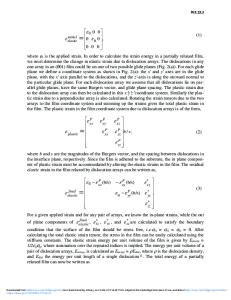Relaxation of Thermal Stress by Dislocation Motion in Passivated Metal Interconnects
- PDF / 1,879,214 Bytes
- 11 Pages / 612 x 792 pts (letter) Page_size
- 76 Downloads / 279 Views
Alan Needleman Division of Engineering, Brown University, Providence, Rhode Island 02912 (Received October 10, 2003; accepted 8 January 2004)
The development and relaxation of stress in metal interconnects strained by their surroundings (substrate and passivation layers) is predicted by a discrete dislocation analysis. The model is based on a two-dimensional plane strain formulation, with deformation fully constrained in the line direction. Plastic deformation occurs by glide of edge dislocations on three slip systems in the single-crystal line. The substrate and passivation layers are treated as elastic materials and therefore impenetrable for the dislocations. Results of the simulations show the dependence of the stress evolution and of the effectiveness of plastic relaxation on the geometry of the line. The dependence of stress development on line aspect ratio, line size, slip plane orientation, pitch length, and passivation layer thickness are explored.
I. INTRODUCTION
The reliability of 1many integrated circuits depends on the failure resistance of metallic interconnects. Typical damage processes that can induce failure in interconnects are void formation and electromigration. These processes are strongly influenced by the stress in the lines that develops as a consequence of the thermal mismatch between the metallic lines and their surroundings. The aluminum and copper alloys used for metallization have coefficients of thermal expansion that differ significantly from that of the silicon substrate to which they are usually bonded. Because the interconnects undergo large temperature excursions during processing, and often during service, their thermo-mechanical response is of interest. Residual stresses in interconnects have experimentally been determined by x-ray diffraction1,2 and by curvature measurements.3–5 Experiments have shown that the presence of a passivation layer results in a triaxial stress state in the line,2,3 a stress state that favors void formation, and that the mechanical behavior of passivated lines strongly depends on their aspect ratio.1,3 A disadvantage of most experimental techniques is that they do not measure stress accurately in small geometries. Moreover, they only measure the average stress in the lines and do not capture stress gradients, which can be large in small confined geometries. Recently developed energy-filtered electron diffraction methods,6 however, may offer significant improvement in this regard. Numerical analyses
DOI: 10.1557/JMR.2004.0158 1216
J. Mater. Res., Vol. 19, No. 4, Apr 2004
based on conventional continuum constitutive characterizations have been used to predict stress evolution in the lines, with the interconnect mainly treated as an elastic7–9 or an elastic-perfectly plastic material.1,10 A key limitation of such approaches is that they cannot account for the size dependence of plastic response in small confined volumes. In our analyses, plastic deformation in the line is treated as resulting from the collective motion of discrete dislocations that
Data Loading...











